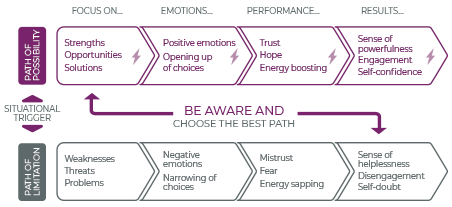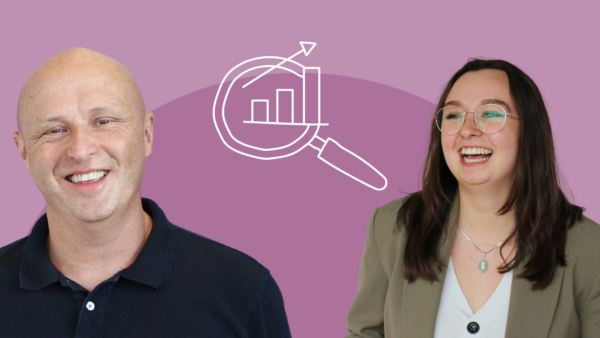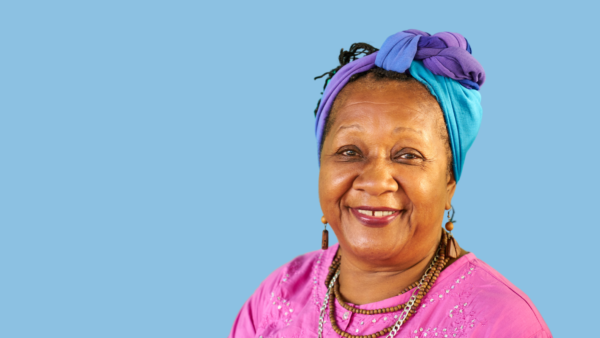There’s negativity all around us and sometimes that can make things feel stuck, like we can’t move forward. It’s relatively easy to get caught up in those negative feelings so our focus can become even more negative. We see even more of the negative when actually nothing much has really changed.
Today’s podcast is all about becoming aware of your mindset and making conscious choices about shifting it when you’re ready to do so. That is, learning how to move from the path of limitation to the path of possibility.
My name’s Dr Paul Brewerton, the strengths guy, I podcast first thing each week to set you up for your best possible week ahead. My podcasts are always and forever about life, work and strengths and how you can get the most from life and from work by keying into your strengths.
The ‘negativity bias’
Before we move into mindset awareness and how to shift your state, I’m going to talk a little about the ‘negativity bias’ and how that can lead us to a place of ‘stuckness‘. The negativity bias in humans means that we generally place more psychological weight on bad experiences than on good ones as the bad things hold more weight for us than the good things. It probably derives from our evolutionary survival drive, when we needed to attend more to negative stimuli in our environment, otherwise we would get poisoned or eaten or hypothermic.
What remains from our earlier selves in evolutionary terms is this predisposition that things of a more negative nature (like unpleasant thoughts, emotions, or social interactions, harmful or traumatic events) have a greater effect on your psychological state and processes than neutral or positive things.
On the flip side, something very positive will generally have less of an impact on your behaviour and thinking than something equally emotional but negative. So that’s our context and programming as humans and it’s important to know, because it shows you that when you get stuck in negative thinking, it’s based on thousands of years of adaptive evolution that served a purpose, so you don’t need to beat yourself up too much, or at all, if you find yourself in that place. I talked about this in more detail way back at season 1, episode 2, so for more on the negativity bias, check out my back catalogue and have a listen.
Our path of possibility model
Now, onward to identifying and managing your mindset with our path of possibility model. Every day we face challenges and opportunities. How we choose to respond is a ‘moment of truth’, as it impacts our effectiveness in navigating our lives. Most people find themselves alternating between the two paths. Their assumptions and interpretation of a situation place them at some point on either path and influence how they respond to the situation.

The path of limitation happens when we interpret a context or situation through a negative lens. This can sometimes lead us to focus on the negative, on for example weaknesses, threats and problems. Here, we experience negative emotions and a narrowing of choices as we’re placing ourselves under stress and pressure…we’re often facing a flight or fight or freeze situation. This can lead us to not trust others, to be fearful and may well sap our energy, ultimately leading to self-doubt, feeling helpless and even becoming disengaged. And we all spend time here some of the time. It is what it is. And it’s ok to feel those feelings, to understand them and to learn from them – what are they telling you, what led you to those feelings, are those thoughts true, do you want to stick with the feelings and thinkings a little more and stay curious as to what else they might mean?
The path of possibility is the path we tread when we view a situation through a more positive lens, so rather than seeing weaknesses, threats and problems, we focus on strengths, opportunities and solutions. This leads to a more positive emotional chain reaction, where we then experience positive emotions and an opening up of our choices, as neurologically we are not in a stress situation and so we can access the decision-making and problem-solving centres of our brain. Our performance in the situation is then underpinned by trust, hope in the future, and a sense of energy and empowerment. We feel powerful rather than helpless, engaged and self-confident rather than doubting ourselves; in short, we feel strong.
So why is this interesting? Firstly, it gives us context for how different people might tackle different situations, and through the language they use, and the decisions they make, we can identify which path they might be on. And that’s helpful when you want to understand someone at a deeper level and support them, or challenge them, in the choices they are making.
Secondly, the path of limitation/path of possibility model also shows us how the strengths approach, and how strengths profiling tools and models can help facilitate awareness and possibilities for people. If you know what it is that energises you, where you feel at your strongest and most in control, and you can key into those strengths, then you’re likely to be able to move towards a positive mindset and make the best choices about actions you can take in any uncertain situation that you face. The strengths approach, particularly knowing your strengths, provides a gateway, a bridge, to the path of possibility.
As an example, imagine that you are going for an interview and you are just stepping inside the interview room with a coffee in your hand. As you walk into the room, you trip slightly and spill the coffee all over your white t-shirt.
There are the two options you can go to here: path of limitation and path of possibility.
- With the path of limitation, you will probably feel panicky, you may criticise yourself for being so clumsy, you might focus on the stain on your t-shirt and won’t be able to focus on your interview, you will be thinking how unprofessional this might look like and will feel like running away.
- If you make the choice to move towards the path of possibility, you might think well, these things happen, I’m still just as excited to let the interviewers see me at my best and after all I’m a human being; let’s make a joke of it, let’s use it as an icebreaker and just continue with the interview.
By the way, it’s likely that your immediate emotional response won’t be path of possibility at all. In fact you probably will feel a little panicky and self-critical. The value of the model is to know that you still have choices. In a ‘moment of truth’ situation like that one, you can get to a point where you can see this emotional response for what it is and shift your mindset towards the path of possibility, if that’s the choice you want to make.
It’s a small example, but it applies in so so many situations, big and small. Look for opportunities to start applying it in your own life today.
For more on this, have a listen to another one of my recent podcasts: Managing stress and change – controlling the controllables, which is nearby at season 7, episode 4. A lot of the content on that podcast talks about your options for taking control in a context of uncertainty to bring any sense of stress and pressure into line and to bring a sense of calm perspective to your thinking and actions. That podcast also talks about the importance of giving yourself a break when times are tough and knowing that it’s not just you experiencing whatever you’re experiencing, there are plenty of other people in a similar place and it’s normal and ok to feel whatever you’re feeling.
So there are my thoughts for this week – the path of possibility is there for you, and strengths can give you a gateway to get there; to remind you of what you bring, of who you can bring to each and every challenge and situation you face, so that you can lean into it positively and be confident that you will find a way through.
But know that it’s OK to not be able to get there quickly, to sit with negative emotions. Be curious about them rather than moving away from them too fast. They may be telling you something important.
This podcast is now available on all major podcast platforms. Find it on Apple podcasts, Spotify, Google podcasts, Stitcher, ACast and Soundcloud. Check out the back catalogue and subscribe to get them every Monday morning.












